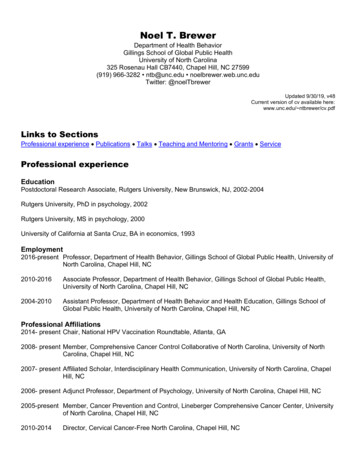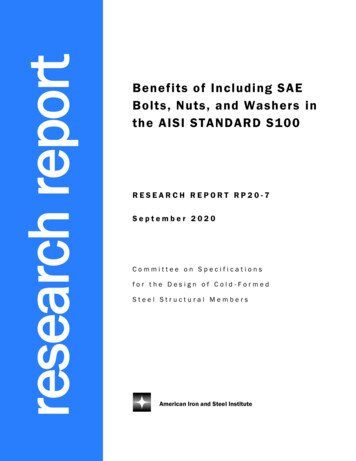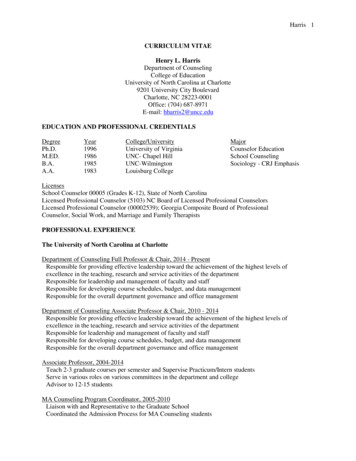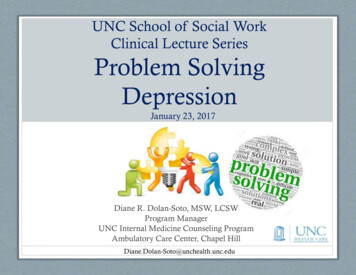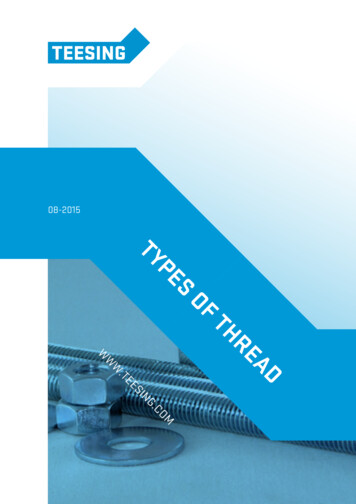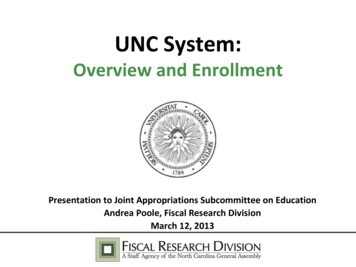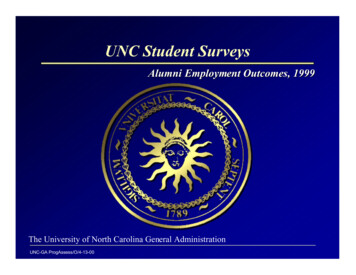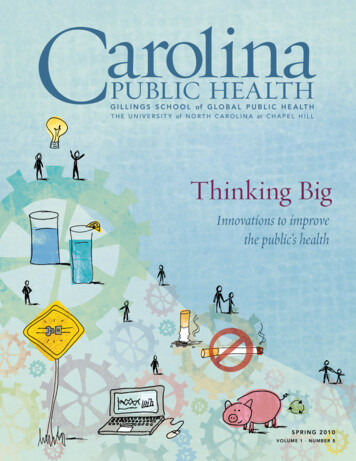
Transcription
Thinking BigInnovations to improvethe public’s healthSPRING 2010volume 1 · number 8
Public Health Foundation, IncorporatedSusanne Glen Moulton, JD, MPH,PresidentDirectorPatient Assistance and ReimbursementProgramsGlaxoSmithKlineJack E. Wilson, PE, MSENV,Vice PresidentBoard of DirectorsTEC IncorporatedDelton Atkinson, MPH, MPH, PMPDeputy DirectorDivision of Vital Statistics, NationalCenter for Health StatisticsCenters for Disease Control andPreventionDavid J. Ballard, MD, MSPH, PhD,FACPSenior Vice President and Chief QualityOfficerBaylor Health Care SystemExecutive Director and BHCS EndowedChairInstitute for Health Care Research andImprovementAndrea Bazán, MPH, MSWPresidentTriangle Community FoundationFred T. Brown Jr., MPH, FACHEManaging DirectorBusiness DevelopmentCarolinas HealthCare SystemKelly B. Browning, MAExecutive Vice PresidentAmerican Institute for Cancer ResearchStacy-Ann Christian, JD, MPHSenior DirectorResearch AdministrationNew York City Health and HospitalCorporationJoan C. Huntley, PhD, MPHAdjunct Professor of EpidemiologyUNC Gillings School of Global PublicHealthMark H. Merrill, MSPHPresident and Chief Executive OfficerValley Health SystemMichael (Trey) A. Crabb III, MHA,MBAManaging Principal - NashvilleStroudwater AssociatesLeah Devlin, DDS, MPHGillings Visiting ProfessorUNC Gillings School of Global PublicHealthCarolina Public Health SolutionsCynthia J. Girman, DrPHSenior DirectorDepartment of EpidemiologyMerck Research LaboratoriesSandra W. Green, MBA, MHA,BSPHPresident, East Coast CustomerManagement GroupMedAssets IncorporatedC. David Hardison, PhDCorporate Vice PresidentLife SciencesScience Applications InternationalCorporationDeborah Parham Hopson, PhD,RNAssistant Surgeon GeneralAssociate AdministratorHIV/AIDS BureauHealth Resources and ServicesAdministrationBOARD OF DIRECTOR SStephen A. Morse, MSPH, PhDAssociate Director for EnvironmentalMicrobiologyNational Center for the Prevention,Detection, and Control of InfectiousDiseasesCenters for Disease Control andPreventionDouglas M. Owen, PE, BCEEVice PresidentMalcolm Pirnie IncorporatedJonathan J. Pullin, MSPresident and Chief Executive OfficerThe Environmental Group of theCarolinas Inc.Roy J. Ramthun, MSPHPresidentHSA Consulting Services LLCJacky Ann Rosati, PhDEnvironmental Scientist andContainment Area LeadU.S. Environmental ProtectionAgencyNational Homeland SecurityResearch CenterJeffrey B. Smith, MHA, CPAPartnerErnst & Young LLPPaula Brown Stafford, MPHExecutive Vice PresidentIntegrated Clinical ServicesQuintiles Transnational CorporationRussell B. Toal, MPHClinical Associate ProfessorHealth Policy and ManagementJiann-Ping Hsu College of PublicHealthGeorgia Southern UniversityJohn C. Triplett, MD, MPHRegional Medical OfficerBethesda, Md.G. Robert Weedon, DVM, MPHVeterinary Outreach CoordinatorAlliance for Rabies ControlAdjunct FacultyUNC-WilmingtonVeterinarianNew Hanover County (N.C.) Boardof HealthAlice D. White, PhDVice PresidentWorldwide Epidemiology DepartmentGlaxoSmithKlineThomas K. Wong, PhDVice PresidentMeganium CorporationIlene C. Siegler, PhD, MPHProfessor of Medical PsychologyDuke UniversityDeniese M. Chaney, MPHPartnerAccenture Health and Life SciencesUNC Gillings School of Global Public HealthADVISORY CO U N C I LDennis Gillings, CBE, PhD, ChairChairman and Chief Executive OfficerQuintilesAndrew Conrad, PhDChief Scientific OfficerNational Genetics InstituteJ. Douglas Holladay, MDivChairman and Chief Executive OfficerPathNorthCarmen Hooker Odom, MSPresidentMilbank Memorial FundMarcia A. Angle, MD, MPHAdjunct ProfessorNicholas School of the EnvironmentDuke UniversityKeith Crisco, MBASecretary of CommerceState of North CarolinaDonald A. Holzworth, MSChairmanFutures Group InternationalJane Smith PattersonExecutive DirectorThe e-NC AuthorityNancy A. Dreyer, PhD, MPHChief of Scientific AffairsOUTCOMEDavid P. KingPresident and Chief Executive OfficerLaboratory Corporation of AmericaKen EudyChief Executive OfficerCapstratA. Dennis McBride, MD, MPHHealth DirectorCity of Milford (Conn.)Joan Siefert Rose, MPHPresidentCouncil for EntrepreneurialDevelopmentRobert J. Greczyn Jr., MPHChief Executive Officer EmeritusBlueCross and BlueShield of NorthCarolinaJohn McConnellChief Executive OfficerMcConnell GolfWilliam K. Atkinson, PhD, MPHPresident and Chief Executive OfficerWakeMedJoseph Carsanaro, MBA, MSEEGeneral ManagerPinehurst Advisors LLCGail H. Cassell, PhD, DSc (hon)Vice President, Scientific Affairs andDistinguished Lilly Research Scholarfor Infectious DiseasesEli Lilly and CompanyWillard Cates Jr., MD, MPHPresident, ResearchFamily Health InternationalJames R. Hendricks Jr., MSVice President of Environment, Healthand Safety (Retired)Duke EnergyGuy Miller, MD, PhDChairman and Chief Executive OfficerEdison Pharmaceuticals IncorporatedJames Patrick O’Connell, PhD, MPHChief Executive OfficerAcea Biosciences IncorporatedVirginia B. SallCo-Founder and DirectorSall Family FoundationCharles A. Sanders, MDChairman and Chief Executive Officer(Retired)Glaxo IncorporatedPaul M. Wiles, MHAPresident and Chief Executive OfficerNovant Health Incorporated
contentsspring 201046features & news3Innovation matters!4Bright ideas, right partners, insightful solutions6 No sugar-coating the crusade against obesit y9111721Flu viruses move fast — so do public health officials10Going Viral11Harnessing vast data to understand COPD13‘Team Science’ advances technology14UNC and UAE partner to protect environment16Peers for Progress17Water power — bringing streams together to make a might y river18How the World Learns20Tracking Tropical Disease21Converting hog waste into energy23Unraveling the mystery of arsenic’s modi operandicontinued 8c a r o l i n a p u b l i c h e a lt h 1
spring 2010DeanBarbara K. Rimer, DrPHdirector of communicationsmanaging editorRamona DuBose24contents, continued2529editorLinda KastlemanAssociate Dean forExternal AffairsPeggy Dean GlennDesign and Production24Safet y first on the job, especially forinexperienced teens25Putting new ideas where their mouths are26school newsKaren HibbertUNC Design ServicesContributing WritersJay Cartwright, Ramona DuBose,Natalie Gott, Linda Kastleman,Kathleen Kearns, Chris Perry, SusanShackelford and Angela SpiveyillustrationsKaren Hibbert29in memoriam30awards and recognitionsour donors33New cervical cancer initiative aims to save lives33Allison composes song to celebrate School34Senkomago selected for Tellus EducationalFoundation Scholarship program35Sanofi-aventis to sponsor new Department ofNutrition scholarship program35biOS turns 60!36One generous turn inspires anotherDelton atkinson, mph: champion of diversit yback page2 SPRING 2 0 1 0Articles appearing in CarolinaPublic Health may be reprinted withpermission from the editor. Sendcorrespondence to Editor, CarolinaPublic Health, Gillings School ofGlobal Public Health, Campus Box7400, Chapel Hill, NC 27599-7400, ore-mail sphcomm@listserv.unc.edu.Subscribe toCarolina Public Healthwww.sph.unc.edu/cph17,000 copies of this document wereprinted at a cost of 11,397 or 0.67per copy.Carolina Public Health (ISSN 19382790) is published twice yearly by theUNC Gillings School of Global PublicHealth, 135 Dauer Dr., Campus Box7400, University of North Carolina atChapel Hill, Chapel Hill, NC 275997400. Vol. 1, No. 8, Spring 2010.
from the Dean’s deskInnovation Matters!Lisa Marie AlbertUNC Chancellor Holden Thorp wants Carolina to be an innovation hub. Asleader of a great public university and a scientist known for chemistry inventions,Thorp understands that innovations play a critical role in improving health andsociety. In this issue of Carolina Public Health, we investigate innovation’s role inour School and its broader implications for public health.Dr. Barbara K. RimerInnovation refers both to some new thing —a product, program or idea thought to be an improvementover what preceded it —and a process of getting thething into practice. In public health, especially in ourSchool, we aim to solve some of the world’s greatestproblems —providing safe water to people who lackit, helping to change unhealthy behaviors, such assmoking and poor diets, reducing errors in operatingrooms and pharmacies, and developing better waysto conduct clinical trials. Too many interventions arecumbersome, costly or culturally inappropriate. Weneed practical, practicable and scalable innovationsthat are transformative. Some inspiring examplesfrom our School include: Mark Sobsey, PhD, and colleagues designed amuch improved ceramic water filter. A crucialtest is its adoption on a scale large enough tomake a difference. Repellent-treated mosquito bed nets are animportant innovation. Faculty members,including Drs. Frieda Behets, Andrea Biddle,Steve Meshnick, Audrey Pettifor and AnneliesVan Rie, conduct field studies to ensure thatnets are adopted in practice.To him who devotes his life to science,nothing can give more happiness thanincreasing the number of discoveries, but hiscup of joy is full when the results of his studiesimmediately find practical applications. Noel Brewer, PhD, and Jennifer Smith, PhD, areamong the first to study how new vaccines toprevent HPV are being adopted. The Safe Dates program, developed by VangieFoshee, PhD, and colleagues, is more effectivethan previous programs; it now is being usedaround the country. Deborah Tate, PhD, was one of the first to takedietary counseling online. Marci Campbell, PhD, was awarded an NIHChallenge Grant for her novel use of microfinance and health behavior interventions toimprove diets in eastern North Carolina. Sue Havala Hobbs, DrPH, and Ned Brooks,DrPH, created a new hybrid-model executiveDoctor of Public Health program that allows students to keep working while earning a doctorate.We have funded 18 Gillings Innovation Laboratories to solve big public health problems andaccelerate solutions. The range of programs, fromdevelopment of new laboratory tests to new ways ofencouraging use of local foods, is impressive.Many innovations are worthy of adoption. Yet,we know that the process of adopting public healthinnovation is painfully slow; people die waiting. Several faculty members, including Alice Ammerman,DrPH, Cathy Melvin, PhD, and Bryan Weiner, PhD,focus on speeding adoption of innovations.Our faculty, staff, students and partners arecreating ideas, programs, tests and tools to improvethe public’s health and translate effective programsinto practice. Together, we bring life to public health“innovation.” It’s a matter of health!–Louis PasteurNote: Rimer also participates in a roundtable discussion about innovation on pages 4–5.c a r o l i n a p u b l i c h e a lt h 3
f e at u r e s a n d n e w sBright ideas,right partners,insightful solutionsVaccines for diseases such as polio and smallpox,fluoridation of drinking water, prenatal care anduse of vitamin A to prevent blindness all are publichealth innovations. So are seat belt laws, clean drinking water, modern sanitation requirements and campaigns against abuse of drugs, alcohol and tobacco.In this century, public health researcherscould discover more advances —preventivesfor cancers, new ways to heal and protectthe environment, effective means to preventobesity and more efficient ways to providehealth care for all.“Innovation in public health brings hopeto all humankind —hope that our childrenand our children's children will live healthier,higher-quality lives without much of the suffering that seems so prevalent in our worldtoday,” says Dennis Gillings, CBE, PhD, chairand chief executive officer of Quintiles andchair of the School’s Advisory Council.Innovation is fundamental at the UNCGillings School of Global Public Health. Thisissue of Carolina Public Health is dedicated tothe outstanding efforts of faculty, students,staff and alumni who are searching for more4 SPRING 2 0 1 0effective vaccines for tougher diseases (seepage 10), finding better ways to provideclean water throughout the world (see page17), waging war against obesity (see page 6),and fighting pollution, cancer and infectiousdiseases.In January 2010, members of the UNCChapel Hill Chancellor’s Innovation Circlevisited the School to hear about some of ourresearchers’ innovative solutions to waterproblems facing the world. The circle is anadvisory council of respected UNC alumniand friends charged with helping to developa roadmap for a culture of systematicinnovation and entrepreneurshipat Carolina. It is chaired byLowry Caudill, PhD, a 1979UNC graduate and co-founderof Magellan Laboratories Inc. Afterthe visit, Caudill said he and other circlemembers were impressed with research beingdone at the School.“Chancellor Thorp’s vision is to transformnew knowledge in the university for maximum societal benefit,” Caudill said. “The(Gillings) School of (Global) Public Health isdoing this already and doing it really, reallywell. I made the point later in the afternoonto the whole group that as we look for bestpractices at other schools like Stanford andMIT, we need to look in our own backyardat the School of Public Health.”So what is innovation?“Innovation is all about creating things,”said Don Holzworth, chair of Futures GroupInternational and the School’s GillingsExecutive in Residence. “It’s about joiningideas that haven’t been joined before, which
ultimately leads to a breakthrough or a moreefficient way of delivering something wealready know about.”Innovation often comes when people withdifferent perspectives join forces to solve aproblem.“The ‘outsider’s perspective’ can stimulatenew ideas,” Holzworth said. “It’s disruptivethinking, but it’s constructive disruption.”The UNC Gillings School of Global PublicHealth is partnering with different departments, universities, government agencies(domestic and foreign), nongovernmentalorganizations, companies and individuals.For example, UNC biostatistics researchersnow work with researchers at Duke and N.C.State universities to find ways to design morepowerful clinical trials for cancer treatments.Their work is funded through a 12.5 milliongrant from the National Cancer Institute(see page 26). UNC public health researchers also have teamed up with officials andacademicians in the United Arab Emiratesand with Rand Corporation and others toassess environmental and public health risksaccelerated by development and to establisha national strategy for addressing those risks(see page 14).“Because everyone’s resources are so limited, it’s more important now than everbefore to be creative and work with partnerswe’ve never worked with before,” said LeahDevlin, DDS, Gillings Visiting Professor andformer North Carolina state health director.Devlin lauds the School’s efforts, especially through the N.C. Institute for PublicHealth (NCIPH), to work with the state’sDepartment of Health and Human Servicesand with local health departments throughout North Carolina.“We are the only state in the country thatrequires accreditation of our health departments to establish consistent standards,”she said.Jane Smith Patterson, executive director ofe-NC Authority and member of the School’sAdvisory Council, echoes Devlin’s enthusiasm for how the state and the university canenhance each other’s work.“By matching public health needs withthe knowledge of university public healthresearchers and public health practitioners,better than their predecessors, cost more andcaused more side effects,” she said.“This comparative effectiveness researchis essential. We must know when newer isnot better.”Innovations are more than inventions,Rimer said.“We care about innovations because inpublic health, and especially in our School,we aim to solve some of the world’s greatestproblems. We must be willing to look at howwe have done things before and ask whetherthere are other, better ways to do a thing. Wewant to create the ideas, programs, tests andtools that make the world better. Those arepublic health products, and they are happening right here, at our School.”And they’re making a difference.“Public health investment and dedicationInnovation is all about creating things It’s about joining ideas that haven’t beenjoined before, which ultimately leads to abreakthrough or a more efficient way ofdelivering something we already know about.–Don Holzworththere is an amazing opportunity to developinnovative programs and practices that canbe taken to scale in close to real time,”she said.But not every innovation is an improvement, cautions Barbara K. Rimer, DrPH,dean and Alumni Distinguished Professorat the School.“In 2005, for example, biostatistics professor Ed Davis, PhD, and others found that newmedicines to treat schizophrenia were notby our university are making the differenceand will continue to do so,” Gillings said.“Moreover, prevention promises hugebreakthroughs, particularly if we can impactselective behavior patterns in cost-effectiveways. I am excited about our opportunity andapplaud our dedicated researchers for theirmotivation and devotion to improving thehealth of us all.”–Ramona DuBosec a r o l i n a p u b l i c h e a lt h 5
f e at u r e s a n d n e w sNo sugar-coating thecrusade against obesityWhen Barry Popkin, PhD, advocates for anational tax on sugar-sweetened beverages,soft-drink makers and food-industry groups attack.“Everybody comes after me,” he says.But Popkin, an internationally recognizedexpert in nutrition and obesity, is unfazed.Savvy, passionate and eager to speak out,he says, “I want to have an impact.”The Carla Smith Chamblee DistinguishedProfessor of Global Nutrition in the University of North Carolina’s Gillings Schoolof Global Public Health and director ofthe UNC interdisciplinary obesity programmakes an impact often.You may have seen his comments in TheNew York Times or Time magazine or heardhim on National Public Radio or Al Jazeera.He’s such a seasoned media source that hemight show up for a satellite interview at the UNC television studios in a shirt and tie—and shortsand sandals. He knows he’ll be% 25visible only from the waist up.Now 66, Popkin was amongthe first researchers to start tracking the effects of diet and activity. His data are based on fourdecades of observation of individuals, households and communities, from Russia to Mexicoand China to Brazil. The worstproblems used to be hunger andmalnourishment. Now, obesity isepidemic in both developed anddeveloping countries.6 SPRING 2 0 1 0He says sugar-sweetened beverages are toblame for much of the weight gain. “You arewhat you drink,” he says. In 1960, the average American consumed 100 to 200 caloriesa day in beverages. Today, the figure is 500calories.In 2005, Popkin assembled leading nutrition experts from Johns Hopkins, Harvard,Louisiana State and Oregon State universities, and other institutions, to study availableliterature and provide guidance on risks andbenefits of various beverage categories. Theirresults were published in The American Journal of Clinical Nutrition in 2006.“The Beverage Guidance Panel that Barryconvened produced a first of its kind —aguide for the kinds of beverages that have thebest value for your health,” says George Bray,MD, Boyd Professor and chief of the divisionof clinical obesity and metabolism at thePennington Biomedical Research Center inBaton Rouge, La., and a member of the panel.Now, Popkin works with governmentsaround the world to establish beverage guideline policies.“France and the U.K. have banned caloricbeverages in schools,” he says. “Mexico hascreated beverage guidelines, and now I amworking with the U.K. and China on this topic.”In the U.S., he advocates a tax on sugarsweetened beverages to discourage peoplefrom drinking them, he says. He and sixother scholars wrote a 2009 report in TheNew England Journal of Medicine that advocated a consumer tax of one percent perPercentage of daily caloric intake from beverage, by age group20Other milk beveragesCoffee and teaAlcohol15Fruit juiceMilk10Fruit drinks50Soft drinksAge2-1819-3940-5960 All Ages
l i n da k a s t l e m a nounce on sugar-sweetened beverages bothto reduce consumption and bring in moneyto support health programs, as tobacco taxeshave done. His latest study, published March9, 2010, in Archives of Internal Medicine,shows that people eat less fast food, such aspizza and burgers, when the prices go up,supporting his proposal to tax these foodsin addition to sugar-sweetened beverages.Not surprisingly, soft-drink makers,supermarket companies, the fast-food industry and other groups poured more than 24million into the coffers of Washington lobby-Popkin says sugar-sweetened beverages areto blame for much of the weight gain.“You are what you drink.”ists in the first nine months of 2009 to fight apotential national tax and other regulations,according to The Huffington Post.Popkin’s recent book, The World is Fat:The Fads, Trends, Policies and Products thatare Fattening the Human Race, draws on whathe’s learned throughout hiscareer. He makes a strongcase that lifestyle changes,including eating more sugary and fatty foods, as wellas government policies andglobalized food marketing,are fueling the weight gain.“How we eat, drink andmove has changed so drastically in the last 60 years,” hesays. “Our biology clasheswith modern marketing andtechnology.”His research examines health implications ofthose policies and lifestylechanges, and his findingshave been published in morethan 300 articles in peerreviewed journals, includingThe New England Journal ofMedicine, Journal of the American MedicalAssociation, Science, Obesity, Circulation andthe American Journal of Clinical Nutrition.His research covers the whole spectrum oflife —for example, he’s published articlesin both Pediatrics and the Journal of Nutrition of the Elderly. His work has appearedin renowned peer-reviewed publications inEurope, China, the Philippines and the AsiaPacific region.His most innovative work, say colleagues,has been developing the concept of “Nutrition Transition,” a way of understandinglong-term nutritional status changes by looking at shifts in the stages of eating, drinkingand activity, underlying societal shifts andresulting effects on body composition.He also has pioneered large longitudinalstudies around the world, including ones inChina, Russia and the Philippines. He’s ledrelated studies in Brazil, Mexico and othercountries, studying some populations forfour decades. “When I came into the field,such studies were not a focus,” he says.His work has played a major role in establishing databases for scholars to study dietand activity. More than 10,000 researchershave downloaded his longitudinal studies. 8Dr. Barry Popkin takes personally his professional campaign for good health,regularly biking to campus for exercise. (Note: Popkin removed his helmet topose for the photo, but he never bikes without it.)c a r o l i n a p u b l i c h e a lt h 7
f e at u r e s a n d n e w sFLUID OUNCESTotal 104SWEETENEDBEVERAGES[20 oz.]SWEETENEDBEVERAGES WITHNUTRIENTS [15 oz.]TEA/COFFEEUNSWEETENED [15 oz.]WATER[46 oz.]“We also need to remove all false advertising that says ‘contains antioxidants’ and triesto connote that a product is ‘heart healthy’when there is no reality to that claim,” hewrites. “We need ways to stop food manufacturers from making misleading claims, andwe need scientists independent of the foodindustry to set healthy guidelines for variousfood categories.”CALORIESTotal 104Total 464SWEETENEDBEVERAGES[20 oz.]TEA/COFFEEUNSWEETENED [15 oz.]WATER[46 oz.]SWEETENEDBEVERAGES WITHNO CALORIES [5 oz.]SWEETENEDBEVERAGES WITHNO CALORIES [1 cal.]WATER [0 calories]SPRING 2 0 1 0SWEETENEDBEVERAGES[211 calories]LOW FATMILK [3 oz.]TEA/COFFEEUNSWEETENED [11 cal.]8 LOW FATMILK [3 oz.]Dr. Barry Popkin is a frequent guest at Carolina News Studio, giving interviews that arebroadcast around the world.FLUID OUNCESSWEETENEDBEVERAGES WITHNUTRIENTS [15 oz.]SWEETENEDBEVERAGES WITHNO CALORIES [5 oz.]l i n da k a s t l e m a n“Barry has made many important contributions to nutrition research,” says PennyGordon-Larsen, PhD, UNC associate professor of nutrition, who has published severalarticles with Popkin. “He is probably most wellknown for his work on the nutrition transition and global obesity. Yet he also has mademajor contributions in investigations on therole of dietary fat in obesity, sugar-sweetenedbeverages and obesity, health disparities, andeconomic determinants of diet and obesity.”Popkin —tall, wiry and agile —attacksobesity many different ways. On a personallevel, he rides his bike to work and aroundtown. He is part of an international boardof scientists helping to develop simple frontof-the-package labels in European countries,Israel and India. He’s working with theMexican Ministry of Health and Finance todevelop a similar program in that country.He also has waded into the U.S. Food andDrug Administration’s review of nutritionlabeling guidelines. In the Feb. 8 issue of TheNew York Times, he wrote: “Placing complicated labeling on the back of the package simplydoes not work. Studies from the Netherlands,the U.S. and elsewhere have found that systemto be confusing and that it does little to affectconsumer decisions. Front-of-the-packagelabeling, which has emerged in the past threeto four years, promises to be more effective.”But he doesn’t stop there.SWEETENEDBEVERAGES WITHSOME NUTRIENTS[213 calories]LOW FAT MILK [29 calories]No wonder he’s a target.However, he also tries to reach out to thefood and beverage industry, encouragingthem to be part of the solution to obesity. In2007, he started an annual “Global ObesityBusiness Forum” with senior executivesfrom food, beverage and infant formulacompanies. The meetings are private, Popkinsays, so the executives can be frank and openabout their concerns and processes.As a college student in the 1960s, Popkinwas active in the civil rights movement nationally and in his home state of Wisconsin. Thoseexperiences, he said, taught him to take theslings and arrows of criticism in stride. “Therewere people who loved you, and people whohated you,” Popkin says. “That’s the way it iswhen you’re fighting for a cause.” n–Susan ShackelfordAmericans drink too much and drink unhealthily.These figures show the beverage intake patternof adults in the U.S., in volume and calories.Drinking 35 oz. of sweetened beverages in aday (out of a total 104 oz.) accounts for abouthalf of the calories consumed from beverages.Popkin’s Beverage Panel suggests the averageadult might best consume 98 oz. in beverageeach day, including up to 50 oz. of water and nosweetened beverage without nutrients.
Flu viruses move fast—so do public health officialspreparing for pandemicThey wanted to determine what people knewabout the vaccine and how many were planning to get immunized. And they needed toknow fast.They found help at the N.C. Center forPublic Health Preparedness at UNC Gillings School of Global Public Health’s N.C.Institute for Public Health. Jennifer Horney,PhD, research assistant professor of epidemiology and deputy director at the center,partnered with UNC public health schoolalumnus Aaron Fleischauer, PhD, a commander with the U.S. Public Health Servicestationed at the N.C. Department of Healthand Human Services in Raleigh, to launch arapid research project.“For any preparedness effort, we want tounderstand how the community perceivesthe public health crisis so we can respondbetter,” Fleischauer says.In this case, telephone interviews weren’tsufficient. Twenty percent of people inthe U.S. have replaced land lines withcell phones, and one of the groups athighest risk for the H1N1 virus—people aged 18 to 25 years—areamong those most likely to bemissed by a traditional phone survey. The team decided to conductin-person interviews, choosing atwo-stage random sample that employed theuse of parcel maps and geographic information systems.“Interviewers use a hand-held computerwith a GPS navigational tool that gives thema map and printed directions that send themto a random point. Then they go to the housethat’s nearest that point and conduct aninterview,” Horney explains.A team of 20 —including state personnel,UNC faculty members and student volunteers—conducted 207 interviews with peopleaged 18 to 92 from two North Carolina counties, Orange and Alamance. The populationbased sampling method yielded interviewsthat would be representative of all the peoplewho live in those counties, Horney says.The study showed that, at least in thesecounties, people may not have been receiving the state’s communications about H1N1,which were mostly online. Only a third of thepeople in the study said they typicallyfound news and information on theInternet, while 83 percent dependedupon television.“It was a big surprise to us thatmost people (in these counties) werestill getting news from television,and even printed newspapers, whichwere the second most common sourcewill owensIn August 2009, two months before the firstshipment of H1N1 vaccine was to arrive in NorthCarolina, officials with the N.C. Division of PublicHealth already were planning how to distribute it.Dr. Jennifer Horneyof information,” Horney says. Also, mostpeople in the survey were unaware that thevaccine would be given in two doses, whichwas the plan at the time of the survey.These findings helped the state create better and more targeted messages.“Once we learned there were pieces ofinformation that the community wasn’tgetting, we made special efforts to get it tothem,” Fleischauer says.The study also showed a greater-thanexpected potential demand for the vaccine,with 63 percent of respondents saying theyplanned to get vaccinated. The one previousstudy regarding H1N1 perceptions—a nationalInternet survey from Rand Corporation—hadshowed that only 50 percent of people plannedto do so. If time and funds are available,Horney aims to follow up in spring 2010, tofind out what percentage of North Caroliniansgot vaccinated. n–Angela SpiveyThe N.C. Center for Public Health Preparedness ispa
Charles A. Sanders, MD Chairman and Chief Executive Officer (Retired) Glaxo Incorporated Paul M. Wiles, MHA President and Chief Executive Officer Novant Health Incorporated Jeffrey B. Smith, MHA, CPA Partner Ernst & Young LLP Paula Brown Stafford, MPH Executive Vice President Integrated
